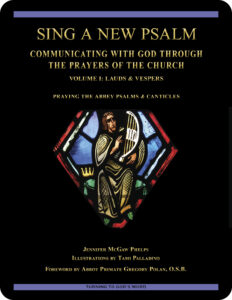 Sing a New Psalm:
Sing a New Psalm:
Communicating with God Through
the Prayers of the Church
Volume I: Lauds & Vespers
Lesson 2 O God, at Dawn I Seek You
Psalm 63, Psalm 93, and Psalm 149
Sunday Lauds (Week I)
Revised Standard Version Catholic Edition (RSVCE)*
New American Bible Revised Edition (NABRE)*
Catechism of the Catholic Church
ex libris (in our library)
next lesson: You Are a Priest Forever
This material coordinates with Lesson 2 on pages 10–13 in Sing a New Psalm: Communicating with God Through the Prayers of the Church—Volume I: Lauds & Vespers. Our Catholic Bible study is based on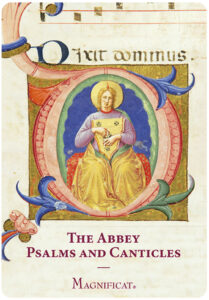 The Abbey Psalms and Canticles, an English translation of the Psalms prepared by the monks at Conception Abbey in 2010 and first published as The Revised Grail Psalms. The Abbey Psalms and Canticles is a revision of that work, finished in 2020 and published by the United States Conference of Catholic Bishops (USCCB). Wording and numbering of some Psalms and verses in other translations may differ. This new translation of the Psalms in the process of being added to all English-language Liturgy of the Hours books used in the United States. The USCCB also plans a liturgical Bible based on the NABRE translation.
The Abbey Psalms and Canticles, an English translation of the Psalms prepared by the monks at Conception Abbey in 2010 and first published as The Revised Grail Psalms. The Abbey Psalms and Canticles is a revision of that work, finished in 2020 and published by the United States Conference of Catholic Bishops (USCCB). Wording and numbering of some Psalms and verses in other translations may differ. This new translation of the Psalms in the process of being added to all English-language Liturgy of the Hours books used in the United States. The USCCB also plans a liturgical Bible based on the NABRE translation.
“Unlike other prayers in sacred Scripture, the prayers contained in the Psalms are not inserted into a narrative story that specifies their meaning and function. Instead, the Psalms are given to the believer precisely as a text of prayer. Since they are the Word of God, the believer who prays the Psalms speaks to God using the very words that God himself has given to us. Thus, in praying the Psalms we learn to pray. The Psalms are a school of prayer.”—Pope Benedict XVI
welcome to our in-depth study of the Psalms
We invite groups and individuals to check out the sample first lesson from this 28- lesson Turning to
lesson Turning to  God’s Word Catholic Bible study. Our online study pages include additional questions, commentary, and prayers based on the Psalm texts. Sing a New Psalm: Communicating with God Through the Prayers of the Church—Volume I: Lauds & Vespers has been granted an imprimatur. A digital version of this study can be purchased from our website shop. Volume II: Vigils, Day Prayer & Compline is scheduled for publication in 2025. If you have a Bible-related question or comment, click on one of the “ask us your question” or “what do you think” buttons on any online study page.
God’s Word Catholic Bible study. Our online study pages include additional questions, commentary, and prayers based on the Psalm texts. Sing a New Psalm: Communicating with God Through the Prayers of the Church—Volume I: Lauds & Vespers has been granted an imprimatur. A digital version of this study can be purchased from our website shop. Volume II: Vigils, Day Prayer & Compline is scheduled for publication in 2025. If you have a Bible-related question or comment, click on one of the “ask us your question” or “what do you think” buttons on any online study page.
open with prayer
It’s always wise to begin any Bible study with prayer, whether reading the Scriptures alone or meeting with others in a discussion study group. You can pray using your own words, pray one of the Psalms in this lesson, or use one of the opening prayers on our website. We especially like the following:
Lord Jesus, you promised to send your Holy Spirit
to teach us all things.
As we read and study your word today,
allow it to touch our hearts and change our lives. Amen.
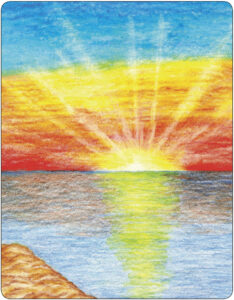 time of day matters
time of day matters
Psalm 63 suggests that morning is an excellent time to pray. This illustration by Turning to God’s Word co-founder Tami Palladino captures the grandeur of sunrise. At the beginning of the day we experience few distractions. We’re rested and alert. The day stretches ahead full of promise. It’s up to us to make wise choices about how we’ll use this gift of time. In our morning prayer we can establish that we wish for God to be the focus of everything we plan. We can think ahead to anticipate challenges and opportunities we may face as our day unfolds. And we can ask God to remain with us no matter what arises. Click on Tami’s illustration (right) to enlarge it. Her original illustration is on page 11 in Sing a New Psalm: Communicating with God Through the Prayers of the Church—Volume I: Lauds & Vespers.
a reflection on the practice of Lauds—you can try daily morning prayer
The following excerpt is from a homily by St. Ambrose of Milan, who was a popular bishop in Italy in the 4th century and was influential in leading St. Augustine of Hippo to convert to Christianity.
“How pleasant to start the day with hymns and canticles, with the beatitudes of the Gospel! What a good beginning to receive the blessing of Christ’s word, and, as you sing the Lord’s praises, to set to work on some virtue, so that you in turn may find yourself worthy of God’s approval.”
WHAT DO YOU THINK would be a good image of God?
The Psalms chosen for Sunday Lauds (Week I) offer a rich collection of ideas that we can use as the basis for meditation and as a springboard for our own personal prayers. Psalm 93 establishes that God rules over all of the world and for all of eternity. The Psalmist uses the image of God being enthroned above the turmoil of the seas to describe God’s power.
 ? Think of some other biblical images of God. What image would you use to describe your personal relationship with God?
? Think of some other biblical images of God. What image would you use to describe your personal relationship with God?
? In Psalm 63, the Psalmist unexpectedly acknowledges that God is better than life itself, a claim that merits our attention. Consider whether you truthfully can make the same claim. Why or why not?
? Where can you look for evidence that might indicate what it is that you truly hold to be of the highest value?
? On what evidence do you think the Psalmist was basing his claim?
a translation difference: adorn versus crown
In The Abbey Psalms and Canticles translation of Psalm 149:4, God adorns the poor with salvation.  Another valid way of translating that passage into English is found in The Revised Grail Psalms, in which God crowns the poor with salvation. The Revised Standard Version Catholic Editions (RSVCE and RSV2CE) translate the same verse as: “For the LORD takes pleasure in his people; he adorns the humble with victory.” Both The Abbey Psalms and Canticles and The Revised Grail Psalms suggest that God wants to share his kingdom with the poor. The RSV translations substitute “adorns” for “crowns,” and also substitute “humble” for “poor,” and “victory” for “salvation.” Consider what might have been in the Psalmist’s mind when he wrote Psalm 149. Which translation do you prefer, and why? For more information, read “God Crowns the Poor with Salvation” on page 12 in Sing a New Psalm: Communicating with God Through the Prayers of the Church—Volume I: Lauds & Vespers.
Another valid way of translating that passage into English is found in The Revised Grail Psalms, in which God crowns the poor with salvation. The Revised Standard Version Catholic Editions (RSVCE and RSV2CE) translate the same verse as: “For the LORD takes pleasure in his people; he adorns the humble with victory.” Both The Abbey Psalms and Canticles and The Revised Grail Psalms suggest that God wants to share his kingdom with the poor. The RSV translations substitute “adorns” for “crowns,” and also substitute “humble” for “poor,” and “victory” for “salvation.” Consider what might have been in the Psalmist’s mind when he wrote Psalm 149. Which translation do you prefer, and why? For more information, read “God Crowns the Poor with Salvation” on page 12 in Sing a New Psalm: Communicating with God Through the Prayers of the Church—Volume I: Lauds & Vespers.
ex libris—the LORD is king
The Lord Reigns: A Theological Handbook to the Psalms by James L. Mays provides insight into the Psalms as an aid to understanding the importance of the 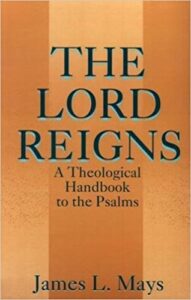 ancient Hebrew view of
ancient Hebrew view of  one God who rules over all of time and space. Mays interprets the phrase “the LORD reigns” as the unifying concept underlying all of the Psalms, making them extremely relevant for those seeking to follow Christ the King in a secular world that generally doesn’t recognize this foundational belief of Christianity. Mays’ book, although somewhat scholarly in tone, offers clear rewards for anyone seeking to understand more about how the Old Testament concept of God as king applies to the present-day practice of the Christian faith. Read excerpts and learn more about The Lord Reigns and other works related to Bible study at ex libris—main bookshelf.
one God who rules over all of time and space. Mays interprets the phrase “the LORD reigns” as the unifying concept underlying all of the Psalms, making them extremely relevant for those seeking to follow Christ the King in a secular world that generally doesn’t recognize this foundational belief of Christianity. Mays’ book, although somewhat scholarly in tone, offers clear rewards for anyone seeking to understand more about how the Old Testament concept of God as king applies to the present-day practice of the Christian faith. Read excerpts and learn more about The Lord Reigns and other works related to Bible study at ex libris—main bookshelf.
how well do you know your faith?
 How thorough is your understanding about salvation, the basic premise of Christian faith? Can you answer the following question without looking at the Catechism of the Catholic Church?
How thorough is your understanding about salvation, the basic premise of Christian faith? Can you answer the following question without looking at the Catechism of the Catholic Church?
True or false: Jesus guaranteed salvation for all men and women.
To learn what the Church teaches, refer to paragraph 1019 in the Catechism of the Catholic Church. What do you consider to be the key word in the Catechism paragraph that explains salvation?
salvation—you could look it up in our archives
 In Psalm 149:4, the Psalmist writes that God provides salvation or victory to a defined group of people. (The exact words vary depending on which English translation you’re reading.) To learn what the word “salvation” means and how it’s linked to ideas of safety, read Lost in Translation, an online column in which Turning to God’s Word author Matthew Phelps helps readers connect with ideas expressed in the original languages of the Scriptures. New Lost in Translation entries are posted on Mondays, and past entries are archived on our website. Contact us if you’d like to receive Lost in Translation by email every week.
In Psalm 149:4, the Psalmist writes that God provides salvation or victory to a defined group of people. (The exact words vary depending on which English translation you’re reading.) To learn what the word “salvation” means and how it’s linked to ideas of safety, read Lost in Translation, an online column in which Turning to God’s Word author Matthew Phelps helps readers connect with ideas expressed in the original languages of the Scriptures. New Lost in Translation entries are posted on Mondays, and past entries are archived on our website. Contact us if you’d like to receive Lost in Translation by email every week.
a two-edged sword
The word of God is likened to a sword several places in the Scriptures, but one of the strongest uses of this image occurs in Psalm 149. Not only 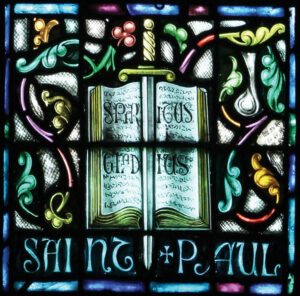 does Psalm 149 suggest that God has given his people a powerful weapon, the Psalmist also indicates that certain conditions apply for those who would wield the sword of truth. What are those conditions? The Psalmist first tells us that God has given this two-edged sword to his faithful, so we can assume such a powerful weapon won’t be very effective in the hands of someone who lacks faith. Secondly, those who would wield the sword of truth must do so with the praise of God in their mouths, which seems to be the Psalmist’s way of suggesting that God’s people must demonstrate their faith by publicly praising God. This injunction perhaps has another spiritual benefit. Consider how easy it would be for someone to use the truth in a malicious manner if he or she also were required to be offering praise to God at the same time.
does Psalm 149 suggest that God has given his people a powerful weapon, the Psalmist also indicates that certain conditions apply for those who would wield the sword of truth. What are those conditions? The Psalmist first tells us that God has given this two-edged sword to his faithful, so we can assume such a powerful weapon won’t be very effective in the hands of someone who lacks faith. Secondly, those who would wield the sword of truth must do so with the praise of God in their mouths, which seems to be the Psalmist’s way of suggesting that God’s people must demonstrate their faith by publicly praising God. This injunction perhaps has another spiritual benefit. Consider how easy it would be for someone to use the truth in a malicious manner if he or she also were required to be offering praise to God at the same time.
 the popes inspire us—a struggle for liberation
the popes inspire us—a struggle for liberation
“Warlike Symbolism” on page 13 in Sing a New Psalm: Communicating with God Through the Prayers of the Church—Volume I: Lauds & Vespers looks at the way military words are used in the Psalms. Pope St. John Paul II explains that in the Psalmist’s perspective, battle images are linked to the dedication of God’s faithful people who must exist amid the evil and injustice of the world. What do you consider to be the greatest battle you currently face? How can God help?
read the Catechism—the king has a bride
The description of the king of heaven in the book of Revelation 19:6–8 bears similarity to the description of the LORD as king in Psalm 93. A key difference is that the king in the book of Revelation also is a bridegroom, while there’s no mention of a bride in Psalm 93. Christians interpret the bride in Psalm 45—the biblical text for Lesson 9 An Overflowing Heart on page 33 in Sing a New Psalm: Communicating with God Through the Prayers of the Church—Volume I: Lauds & Vespers—as a type of the Church. Paragraph 773 in the Catechism of the Catholic Church sheds light on the nuptial image frequently used in Scripture to describe the union of humanity and divinity.
 773 In the Church this communion of men with God, in the “love [that] never ends,” is the purpose which governs everything in her that is a sacramental means, tied to this passing world. “[The Church’s] structure is totally ordered to the holiness of Christ’s members. And holiness is measured according to the ‘great mystery’ in which the Bride responds with the gift of love to the gift of the Bridegroom.” Mary goes before us all in the holiness that is the Church’s mystery as “the bride without spot or wrinkle.” This is why the “Marian” dimension of the Church precedes the “Petrine.”
773 In the Church this communion of men with God, in the “love [that] never ends,” is the purpose which governs everything in her that is a sacramental means, tied to this passing world. “[The Church’s] structure is totally ordered to the holiness of Christ’s members. And holiness is measured according to the ‘great mystery’ in which the Bride responds with the gift of love to the gift of the Bridegroom.” Mary goes before us all in the holiness that is the Church’s mystery as “the bride without spot or wrinkle.” This is why the “Marian” dimension of the Church precedes the “Petrine.”
Y ou can learn more about the heavenly bridegroom in Lesson 20 The Mighty Voice of a Great Multitude in the Turning to God’s Word Catholic Bible study The Revelation of Jesus Christ: The Faithful Witness.
ou can learn more about the heavenly bridegroom in Lesson 20 The Mighty Voice of a Great Multitude in the Turning to God’s Word Catholic Bible study The Revelation of Jesus Christ: The Faithful Witness.
a study leader shares her thoughts
The following exchange veers from our standard question-and-answer format. It comes from a study leader in a group planning to tackle one of our other studies.
comment: Thank you for your online study pages. They’re such a bonus. In our Bible study, more  questions come up in our leaders’ group than in my individual group about why you ask a certain question, or what you might be thinking, or where you’re leading with your questions. I’ve often been able to point to the online study pages for direction and clues. I need to remind the other group leaders and myself that you’re trying to get us to think and pray about Scripture and its impact in our lives rather than limiting Bible study to an assignment that can be completed with a single academic answer.
questions come up in our leaders’ group than in my individual group about why you ask a certain question, or what you might be thinking, or where you’re leading with your questions. I’ve often been able to point to the online study pages for direction and clues. I need to remind the other group leaders and myself that you’re trying to get us to think and pray about Scripture and its impact in our lives rather than limiting Bible study to an assignment that can be completed with a single academic answer.
response: We appreciate your comments, especially since we know that these online study pages aren’t everyone’s cup of tea. We go to some effort to provide optional information here and in the videos for participants interested in digging a little deeper.
Matthew, Tami, and I feel that it’s important for people to know that sometimes asking the right questions is more valuable than having all the answers. It took us at Turning to God’s Word some time to reach this idea. The bottom line is that no one’s able to hold onto information that they’re spoon-fed the same way that they can remember and live it when they have to dig out concepts themselves. This is a big departure from the scholarly model of Bible study where everyone expects an expert to tell them what the Scripture means, what’s important, and why. Sometimes when one of us sits in with a group, someone will ask what we had in mind when we wrote a particular question. People almost always find it shocking when they’re told that we were thinking we wouldn’t mind hearing a discussion about how others view the Scripture passage that sparked the question.
Studying Scripture presents some special stumbling blocks. Some images and ideas in the Old Testament we might or might not recognize as also occurring in the New Testament. There’s a danger that we become so concerned with understanding the message as it originally would have been received, especially in the Old Testament, that we miss noticing that everything points toward Jesus. Then there’s the other side of that danger, in which we concentrate so much on a Christian interpretation that we miss important historical information that can shed light on Jesus and what he came to do. Finally, there’s a very real danger that we will begin to view Jesus as the end point and so miss seeing that the work of the Church only begins with Jesus’ death and Resurrection.
It’s easy to get derailed in one area and miss the big picture, which is why group discussion is helpful. If one person is focusing on history, someone else may be looking at the way the writing points to Jesus. Another person may be concentrating on how these ancient books are relevant in the present-day world. These different points of view combine to give us a clearer picture of who God is and what God is saying to us in Scripture.
more about the online study pages
We hope that some people will find Bible study so compelling that they’ll want more information than realistically fits in the study books. We want to provide a vehicle for extra material and an easy way for people to ask questions and make comments, especially with so many contradictory views floating around on the Internet and elsewhere.
It’s also our intent that the books, online study pages, and videos each be able to stand alone if need be. We don’t want financial concerns or the lack of a compatible group to prevent anyone from reading and praying with the Bible. We know that there are people in our groups who never look at the website or watch the videos, just as there are people who do those things and more. The only really necessary part of studying the Bible, however, is reading the Bible. Everything else is secondary.
The caution we would add is that if you’re limiting your Bible study experience to reading the Bible—andyou’re aware that you don’t understand what you’re reading—you probably should take a  look at our online commentaries and listen to any related videos. Our Turning to God’s Word authors frequently address some of the more obvious difficulties in those places. If you’ve read all of our related commentaries and watched our related videos and still have questions, shoot us an email. We’re always happy to discuss Scripture, and some of our most cherished insights have come about in conversation with others.
look at our online commentaries and listen to any related videos. Our Turning to God’s Word authors frequently address some of the more obvious difficulties in those places. If you’ve read all of our related commentaries and watched our related videos and still have questions, shoot us an email. We’re always happy to discuss Scripture, and some of our most cherished insights have come about in conversation with others.
the best Catholic commentary about Scripture
 To find out more about how Church teaching is supported by passages in Sing a New Psalm: Communicating with God Through the Prayers of the Church—Volume I: Lauds & Vespers, check out the Index of Citations in the Catechism of the Catholic Church. Links to the primary Scripture passages in the lesson (Revised Standard Version Catholic Edition [RSVCE*]) and relevant paragraphs in the Catechism are provided here. Not every passage in the biblical text for this study is referenced in a Catechism paragraph, however, including Psalm 63, Psalm 93, and Psalm 149 in this lesson.
To find out more about how Church teaching is supported by passages in Sing a New Psalm: Communicating with God Through the Prayers of the Church—Volume I: Lauds & Vespers, check out the Index of Citations in the Catechism of the Catholic Church. Links to the primary Scripture passages in the lesson (Revised Standard Version Catholic Edition [RSVCE*]) and relevant paragraphs in the Catechism are provided here. Not every passage in the biblical text for this study is referenced in a Catechism paragraph, however, including Psalm 63, Psalm 93, and Psalm 149 in this lesson.
don’t forget about our indexes & extra online material

 If you’re trying to locate information about a specific Scripture passage, you can look it up in the index at the back of the study book or sample lesson. If you want to find a particular commentary, you can look up its title in the topics index. To learn more about another book of the Bible for which there’s a Turning to God’s Word study, visit the online study directories to read the commentaries and watch any accompanying videos. Finally, if you have a question or would like to make a comment about any of our studies, you can use one of the “ask us your question” or “what do you think” buttons to email our authors.
If you’re trying to locate information about a specific Scripture passage, you can look it up in the index at the back of the study book or sample lesson. If you want to find a particular commentary, you can look up its title in the topics index. To learn more about another book of the Bible for which there’s a Turning to God’s Word study, visit the online study directories to read the commentaries and watch any accompanying videos. Finally, if you have a question or would like to make a comment about any of our studies, you can use one of the “ask us your question” or “what do you think” buttons to email our authors.
ex libris—Church documents & books about religious topics
Link to magisterial documents referred to in our Bible studies at ex libris—magisterial documents.  This listing includes significant recent encyclicals as well as a number of historical Church documents. Recommended books related to Scripture study can be found at ex libris—main bookshelf.
This listing includes significant recent encyclicals as well as a number of historical Church documents. Recommended books related to Scripture study can be found at ex libris—main bookshelf.
wondering how to pronounce some of these words?
The following links are to readings from the New International Version (NIV) Bible. To listen, open one of the links and click on the audio icon above the printed text. Although not taken from the translations used in our study materials, the NIV readings provide an audio guide to pronunciation of words in this lesson’s primary biblical texts. A close online version of the translation of the Bible used in Catholic liturgy in the United States as well as an audio guide for daily Mass readings for the current month can be found on the website of the United States Conference of Catholic Bishops (USCCB).
Psalm 63 (NIV)
Psalm 93 (NIV)
Psalm 149 (NIV)
 close with a Psalms-based prayer for Sunday Lauds (Week I)
close with a Psalms-based prayer for Sunday Lauds (Week I)
Many of our Catholic study groups like to conclude their discussions with a prayer based on the scriptural focus of their lesson. If you’re uncomfortable composing your own Bible-based prayers, you can follow our four easy steps. If you prefer, you can pray any of the Psalms in this lesson, or you can use the following short prayer.
O God, who were and are and are to come,
increase our gratitude for the gift of time that you’ve given us.
Grant that we may wake each morning
eager to begin another day praising your name.
We ask this through your Son, Jesus Christ,
whose rising from the dead brought
with it a new day of salvation. Amen.
Lesson 3 You Are a Priest Forever, Sunday 2nd Vespers (Week I)—Psalm 110, Psalm 111, and Psalm 112
Lesson 1 Set a Guard on My Mouth, Sunday 1st Vespers (Week I)—Psalm 141, Psalm 142, and Psalm 119:105–112
you also may like our two-part study of the prophets
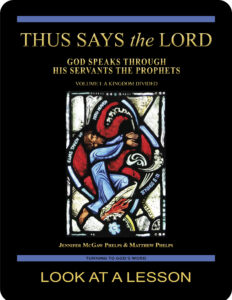
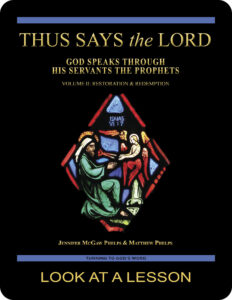 Thus Says the LORD: God Speaks Through His Servants the Prophets—Volume I: A Kingdom Divided examines the prophets in their historical context using the First and Second Books of the Kings and other Old Testament passages written before the Babylonian Exile in 586 B.C. Volume II: Restoration & Redemption looks at the post-exilic prophets. This 51-lesson Catholic Bible study builds on The United Kingdom of Israel: Saul, David & Solomon Foreshadow Christ the King. Click on the books’ covers to view a sample lesson from each volume.
Thus Says the LORD: God Speaks Through His Servants the Prophets—Volume I: A Kingdom Divided examines the prophets in their historical context using the First and Second Books of the Kings and other Old Testament passages written before the Babylonian Exile in 586 B.C. Volume II: Restoration & Redemption looks at the post-exilic prophets. This 51-lesson Catholic Bible study builds on The United Kingdom of Israel: Saul, David & Solomon Foreshadow Christ the King. Click on the books’ covers to view a sample lesson from each volume.
start a Turning to God’s Word Bible study
Thank you for your interest in Sing a New Psalm: Communicating with God Through the Prayers of the Church—Volume I: Lauds & Vespers. 
 More information about beginning a Turning to God’s Word Bible study can be found on this website at start a Bible study, and Tami, Matthew, and I are available to answer questions or discuss concerns. Contact us to start this or one of our other studies or to have your schedule listed with other TtGW study groups on our website. —Jennifer
More information about beginning a Turning to God’s Word Bible study can be found on this website at start a Bible study, and Tami, Matthew, and I are available to answer questions or discuss concerns. Contact us to start this or one of our other studies or to have your schedule listed with other TtGW study groups on our website. —Jennifer
*There are seven deuterocanonical books in the Old Testament—the Books of Tobit, Judith, Wisdom, Sirach, Baruch, and First and Second Maccabees, as well as some passages in the Books of Esther and Daniel. Protestants usually refer to these works as “apocryphal,” a word that means “outside the (Protestant) canon” because they’re excluded from most Protestant Bibles. The word “deuterocanonical” means “second canon”; Catholics use that word to refer to any section of the Catholic Old Testament for which there are no extant, or existing, Hebrew manuscripts. All of the deuterocanonical books appear in the Septuagint, the earliest remaining versions of which date to the 1st century B.C. This Greek translation of the Old Testament was in common use by Jews at the time of Jesus. Learn more by reading How Do Catholic & Protestant Bibles Differ?
Turning to God’s Word printed Bible studies use the 2006 Revised Standard Version Second Catholic Edition (RSV2CE) translation for all Scripture references except the Psalms, which are taken from The Abbey Psalms and Canticles, prepared by the monks of Conception Abbey and published in 2020 by the United States Conference of Catholic Bishops (USCCB). All Scripture links for the online study pages for Sing a New Psalm: Communicating with God Through the Prayers of the Church—Volume I: Lauds & Vespers are to the 1966 Revised Standard Version Catholic Edition (RSVCE) translation. The New International Version (NIV) audio recordings follow the same chapter and verse numbering as the RSV Catholic translations, but the NIV doesn’t include the deuterocanonical passages.
The 1966 RSVCE uses archaic pronouns and verb forms such as “thee,” “thou,” “didst” in the Psalms and in direct quotations attributed to God. The 2006 RSV2CE replaces these with more accessible English. The few significant translation changes in the RSV2CE include rendering almah as “virgin” in the Book of Isaiah 7:14 and restoring the term “begotten” in the Gospel According to John 3:16.
The Psalms in this Bible study reflect numbering used in The Abbey Psalms and Canticles; Psalms numbering may vary in other translations. Numbering also may vary for a few other passages in this Bible study. Turning to God’s Word studies follow the numbering in the Revised Standard Version Catholic translations (RSVCE and RSV2CE). Discrepancies in the New American Bible Revised Edition (NABRE) are noted in the Index of Scripture Citations in the study book and the online sample.
 The companion to this Catholic Bible study from Turning to God’s Word, Sing a New Psalm: Communicating with God Through the Prayers of the Church—Volume II: Vigils, Day Prayer & Compline, will cover Psalms not included in Volume I: Lauds & Vespers. Volume II: Vigils, Day Prayer & Compline is scheduled for publication in 2025.
The companion to this Catholic Bible study from Turning to God’s Word, Sing a New Psalm: Communicating with God Through the Prayers of the Church—Volume II: Vigils, Day Prayer & Compline, will cover Psalms not included in Volume I: Lauds & Vespers. Volume II: Vigils, Day Prayer & Compline is scheduled for publication in 2025.
